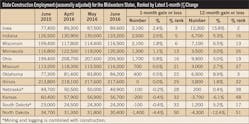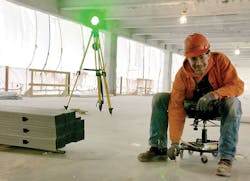In the heart of the country, electrical contracting companies are competing for new opportunities fueled by the economic recovery. One case in point is Lemberg Electric in Milwaukee, which has experienced an explosion of opportunities, says David Washebek, the company’s president and CEO.
“Milwaukee woke up a few years ago, and it has finally started to get some traction,” Washebek says. “The metro area had some pent-up demand coming out of the recession, and we’re extremely busy across every segment of our business.”
Wisconsin is one of 10 Midwestern states that reported a 12-month gain in construction employment, according to the Associated General Contractors of America, Arlington, Va. Only two states — Kansas and North Dakota — experienced a drop in construction employment, while Iowa led the region with a 15.8% growth (see Table).
Meanwhile, in Missouri — which had a 2.7% growth in construction employment — contractors are seeing gains in construction opportunities, but not yet to pre-2008 and 2009 levels, says Dennis Stowell, vice president of Kansas City, Mo.-based Capital Electric Construction Co., Inc.
“Even though construction levels are increasing, we are not seeing a significant amount of the larger projects, which increases the amount of competition from smaller union and non-union contractors,” Stowell says. “What is encouraging is that we are hearing talk of many larger projects in the pipeline.”
In nearby St. Louis, Guarantee Electrical Construction Co. is seeing an uptick in new projects, but most of them are on a larger scale. As a result, it has left many companies in a have or have-not consequence, says Dave Gralike, senior vice president.
“A company’s perception of the market varies greatly; if you secured one of the large projects, you appreciate the new economy — if you missed out, or are unable to compete on the large projects, the economy still appears stagnant,” Gralike says. “The limited amount of medium-sized projects are targeted by every size contractor, increasing competition and driving down margins.”
Diversifying market segments
To compete in the Midwest electrical construction market, contractors are relying on various strategies. For example, Washebek says diversification has been key to his company’s success over the last 15 years. Lemberg Electric has established defined divisions, which are each led by a dedicated department manager who oversees the budget. For example, the electrical contractor now offers the following services: electrical construction, datacom, sign design and installation, energy technology, solar electric, lighting control, power quality analysis, thermographic scanning, and service.
“If the construction market falls down here, we can focus our attention on other divisions and promote them because we don’t have all of our eggs in one market,” Washebek says.
Stowell says his firm takes a similar approach — it is well diversified in the work it pursues, and it has a large, well-seasoned workforce with many years of experience. As such, the company is able to move into another market sector when work slows in a particular area, such as retail and commercial office space.
Embracing technology
Beyond diversification, contractors are also focusing on other strategies — such as investing in technology. To distinguish itself from the competition, Guarantee Electrical is embracing and implementing technology on every level. For example, the electrical contractor is constantly monitoring its standard operating procedures and ensuring that all of the processes are completed through its accounting software.
“We monitor everything — as today’s jobs have no margin for error,” Gralike says.
In addition, Guarantee Electrical has also invested in five robotic station layout machines, which reduces the layout time while increasing accuracy. The company has also distributed more than 200 iPads to its field supervisors, allowing them to administer their responsibilities — such as morning safety huddles, safety inspections, and labor reporting — electronically and efficiently. The tablets not only provide instant communication through e-mail, but also allow supervisors to FaceTime their managers for an instantaneous review of any concern or fly-through the project models created by MEP software.
Guarantee Electrical has invested heavily in modeling software, and it can use the models to prefabricate and modularize the installations. All of the conduit is bent in accordance with the model, the support brackets and trapeze arrangements are premanufactured, and the wire to be pulled into the conduit is harnessed in the shop as well.
The prefab shop has grown from one wireman and an apprentice to 14 employees on average. By ramping up its prefabrication capabilities, Guarantee Electrical was able to increase productivity of its architectural and MEP contractors on a current large health care project. After constructing the headwalls of metal studs, the mechanical contractor installed the med-gas piping, and Guarantee Electrical installed the electrical and low-voltage rough-ins. Next, the shop modeled the headwalls to align with the overhead carriers, which were constructed in 30-foot sections of metal channel to contain the med-gas, duct work, water, electrical, and low-voltage conduit. Before the floors were even poured, Guarantee Electrical had already completed the carriers and headwalls. Then, once the floors were prepared for MEP commencement, the team could hoist the carriers and stand up the headwalls beneath them — saving hundreds of manhours and countless schedule days, according to Gralike.
“If you’re still stick-building and not prefabbing and/or modularizing, it’s going to remain a tough market,” Gralike says.
Recruiting and retaining labor. Due to its reliance on technology, Guarantee Electrical is not suffering from a shortage of skilled workers. Because its prefabrication shop can pre-manufacture assemblies, the contractor no longer needs to devote a hundred men and women to a job when the floor is ready and can instead lower and level its manpower requirements.
“Projects do not require the same number of craftsmen as years past,” Gralike says. “The increase in project efficiency means that crews are smaller, and projects are faster.”
At the same time, however, Guarantee Electrical is demanding a different skillset from its field employees. For example, 10 years ago, Guarantee Electrical’s most coveted supervisor could envision what a project looked like and complete and perform rapid layout. Today, that’s no longer a need because anyone can fly-through a model and envision a complete project. Also, the robotic station layout eliminates the need for strings and stakes.
In regard to office employment, Guarantee Electrical is striving to create an entrepreneur culture with a high sense of teamwork, and it routinely surveys its employees and receives positive feedback. As a result, the company has received an award from the St. Louis Post Dispatch as one of the “Best Places to Work” for several years in a row, Gralike says.
While finding qualified labor is not a top challenge for Guarantee Electrical, other Midwestern electrical contractors are having a tough time recruiting and retaining skilled field and office employees. This becomes an even more daunting issue when hiring traveling electricians.
Steve Theodoru, vice president of U.S. operations for the State Group, says in the Midwest, contractors are faced with the challenge of developing, maintaining, and supervising a traveling workforce who is skilled, experienced, committed, motivated, and able to address customers’ needs. As an incentive, he says his company offers some flexibility to its traveling workforce with turnarounds and modified work weeks, and it also rewards performance with a bonus structure tied to overall company performance.
In addition, to offset the shortage of qualified labor in the marketplace, the State Group is looking to increase its supervision ratios. Also, to place value on each employee, the contractor is instilling and reinforcing a robust safety program and culture.
“People are our greatest asset, and, as such, we have a vested interest in ensuring their safety,” Theodoru says.
In addition, the contractor focuses on giving the field workforce the proper tools to do the job and introducing technology to the workplace to streamline the paper process.
For Capital Electric Construction, which conducts the majority of its work in the greater Kansas City metropolitan area, field labor has not been an issue this year but may become more of a challenge next year, Stowell says. Because the contractor has experienced some difficulty finding qualified project managers, it is actively recruiting through area universities to fill the void.
Meanwhile, Lemberg Electric’s marketing manager and HR director are working together through its website to recruit for the open positions at the company.
“As this year ends and the next year starts, it’s difficult to find quality field personnel, and project management help is also tougher to find,” Washebek says.
Facing slim margins
In the Midwest, contractors are facing not only a labor shortage, but also a competitive market, tight schedules, and slim margins. In his experience, Theodoru says clients are looking for a one-stop shop — quality contractors that can provide consistent service, which matches their needs and geographic footprint. In turn, contractors are faced with the challenge of the quality of the bid packages as well as schedules.
“Engineering is often fluid or incomplete, making it difficult to define scope and cost,” Theodoru says. “Schedules have become compressed to the point that there is no margin for error.”
To handle this challenge, the State Group is becoming more selective as to what work it pursues and who it works with, and is focusing on developing loyalty and trust with its clients.
“The trick is to know your costs, stick to your margins, and be prepared to walk away,” Theodoru says. “Become the go-to company even when the request might not be a core competency. Find a way to be effective and efficient.”
In addition, the State Group is trying to promote the value it brings instead of what it costs. As a performance-based contractor versus a cost-based contractor, the company’s approach is to focus on quality performance while adhering to project timelines. As a result, it can develop longer term relationships with its clients.
To confront these issues, the State Group has become creative to suit the specific opportunity. For example, the company has opened offices in strategic areas or partnered with local companies to bring expertise.
Washebek says he belongs to a peer group, and, as such, he has learned about how Milwaukee compares to other parts of the country.
“Without a doubt, we operate under much thinner margins here than in other parts of the country,” Washebek says. “It’s very competitive here.”
Stowell agreed, saying that there was no shortage of competition in his market. To handle this challenge, Capital Electric Construction tries to select the larger projects, which eliminates some of the smaller competitors that don’t have the financial resources to undertake these projects. Also, the company is always looking to improve margins through selection of the best projects matching its expertise, the increased usage of technology, the usage of national buying agreements through its parent company MDU Construction Services Group, Inc., and maximizing the use of prefabrication and shared resources with its sister companies.
Embracing opportunities
While electrical contracting companies are facing their share of challenges in the Midwest market, they are also discovering new opportunities and strengthening markets.
In the Kansas City area, Stowell says the renovation of existing buildings for multi-family use and new apartment building construction are still strong. In addition, a number of K-12 school district bond issues are planned for the first half of 2017, and several new facilities are planned for the local universities. In addition, new health care projects are in the planning stages, industrial work is steady, service work is growing, and several aviation projects are underway.
While hospital construction has slowed down in metropolitan Milwaukee, Washebek is still seeing activity in this sector in the smaller towns in the surrounding areas. Because Lemberg Electric has engineers on staff, it doesn’t need to wait for general contractors to call and invite it to bid on projects. Instead, it can take on design-build projects in the health care and other sectors. For example, the contractor recently finished a new hospital in Burlington, Wis., and plans to do another one in March. Also, Meijer, a retail chain that competes with Wal-Mart, is making a big push into Wisconsin, and Lemberg is also working on building new malls.
“Medical and hospital work continues to be strong, commercial is exploding, and we’re building and renovating both private and public schools,” Washebek says.
In not only Wisconsin, but also in the St. Louis area, the health care market is providing more opportunities. As the bubble of the large population is aging, it has changed the needs of society, Gralike says.
“I’m known to always say, ‘Thank goodness for the Baby Boomer generation,’” Gralike says. “Health care and assisted-living developments have been a great market for us. We anticipated the market change and focused heavily on becoming health care constructors, and it was a good bet as health care has been our largest market for several years.”
Those late-arriving contractors into the health care market, however, have had an uphill battle, Gralike says.
“If you can’t speak with authority regarding infection control, HIPAA laws, ACA, etc. — you’d best stay in commercial construction,” Gralike says.
As far as industrial construction, the market has been substantially mitigated — with the exception of infrastructure, Gralike says. For example, Guarantee Electrical has completed several wastewater treatment plants, with several more under construction on the books.
In the Midwestern states that the State Group operates in, Theodoru says the midstream oil and gas transportation market has maintained a steady demand, and he expects robust long-term spending forecasts to run through 2035. He attributes the strength in this market sector to the bottlenecks created in moving the shale gas to market and the conversion of coal-fired power plants to natural gas.
In addition, Theodoru says the automotive industry is also coming off of a record year of sales, and, as a result, the major manufacturers are continuing to invest in retooling and facility upgrades. Moreover, the prime metals industry — which is fueled largely by the auto industry — is starting to rebound, particularly on the finished products side.
As electrical contracting companies look to embrace these opportunities and overcome industry challenges, they are optimistic for a bright future.
“We’re in a good spot, and I feel fortunate because I think it will last for a few years,” Washebek says.
Fischbach is a freelance writer based in Overland Park, Kan. She can be reached at [email protected].






